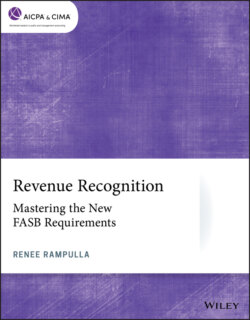Читать книгу Revenue Recognition - Renee Rampulla - Страница 65
Knowledge check
Оглавление1 Which statement best describes an implied promise in a contract with a customer?It needs to be explicitly stated in the contract.May be part of an entity’s customary business practice.May be part of an entity’s competitor’s customary business practice.Creates an unreasonable expectation of the customer.
2 An entity may elect to not account for shipping and handling activities as a separate performance obligation providing:The shipping and handling activities occurred before the customer obtains control of the goods.The shipping and handling activities occurred after the customer obtained control of the good.The shipping and handling activities were an established customary business practice by the entity.The shipping and handling activities were explicitly stated in the contract with the customer.
Determining when a good or service has been identified as distinct
When goods and services are distinct
In order to determine whether a promised good or service in a contract is a separate performance obligation, an entity will need to assess whether that good or service is distinct. Therefore, FASB ASC 606 explains that a good or service promised to a customer is distinct if both of the following criteria are met:
The customer can benefit from the good or service either on its own or together with other resources that are readily available to the customer (that is, the good or service is capable of being distinct).
The entity’s promise to transfer the good or service to the customer is separately identifiable from other promises
A series of distinct goods or services has the same transfer pattern to the customer if both of the following criteria are met:
Each distinct good or service in the series that the entity promises to transfer to the customer would meet the criteria to be a performance obligation satisfied over time.
The same method would be used to measure the entity’s progress toward complete satisfaction of the performance obligation to transfer each distinct good or service in the series to the customer.
In assessing whether an entity’s promises to transfer goods or services to the customer are separately identifiable at the inception of the contract, an entity will need to determine the following:
Whether a customer can benefit from the good or service if the good or service could be used, consumed, sold for an amount that is greater than scrap value, or otherwise held in a way that could generate economic benefits. Keep in mind that with some goods or services a customer may be able to benefit from a good or service on its own.
Whether a customer is able to benefit from the good or service only in conjunction with other readily available resources. A readily available resource is a good or service that is sold separately (by the entity or another entity) or a resource that the customer has already obtained from the entity (including goods or services that the entity will have already transferred to the customer under the contract) or from other transactions or events. Various factors may provide evidence that the customer can benefit from a good or service either on its own or in conjunction with other readily available resources. For example, if an entity regularly sells a good or service separately indicates that a customer can benefit from the good or service on its own or with other readily available resources.
